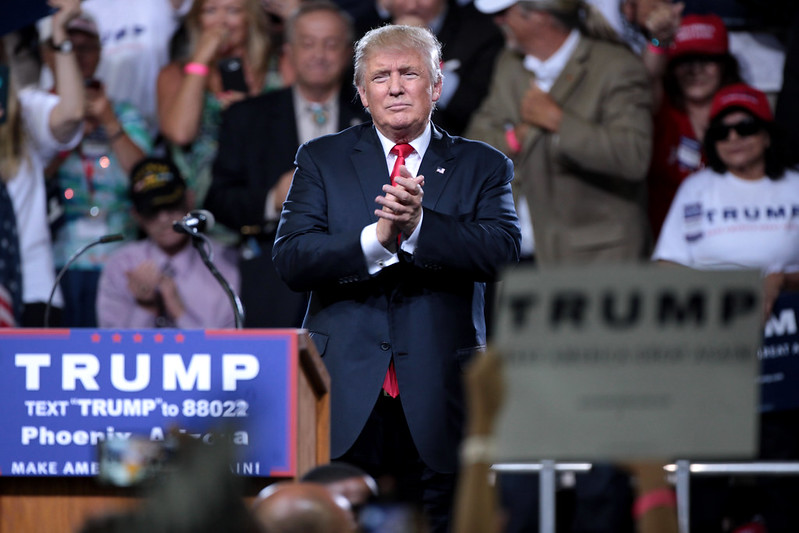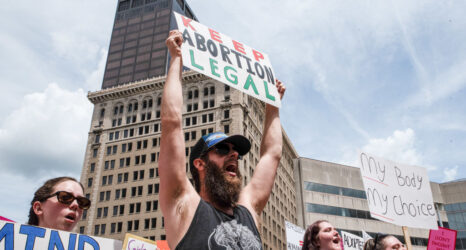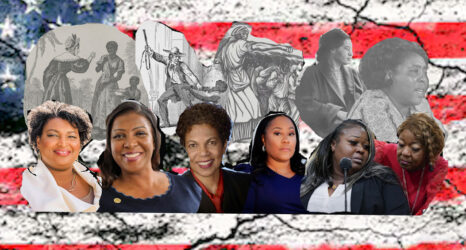
This article was adapted from an episode of the Ms. podcast “On the Issues With Michele Goodwin”: Can the President Suspend the Elections? Listen to the full episode here:
Does the president have the power to suspend the elections?
The short answer: No.
But while the law is clear, President Trump’s efforts to delay the elections, sow distrust in our democratic processes, and wreak havoc on the U.S. electoral process are already well underway.
On July 30, President Trump tweeted mail-in voting will make this year’s elections “the most inaccurate and fraudulent election in history.” (In reality, mail-in voter fraud averages 0.0025 percent.)
This tweet came just months after he and others dismissed Democratic nominee Joseph Biden’s warnings in April that Trump might “try to kick back the election somehow” or “come up with some rationale why it can’t be held.”
And in the meantime, Trump has hammered this idea home—as recently as Tuesday’s first presidential debate, where he falsely claimed West Virginia postal workers are “selling the ballots” and that mail ballots are being “dumped in rivers” and “creeks.”
These commentaries raise serious questions about the authority of the president and the integrity of the upcoming elections.
It’s clear the president does not have the legal authority to suspend the election—Article II of the Constitution gives Congress the power to “determine the time of choosing the electors and … the day on which they shall give their vote.”
But, while the president doesn’t have the legal authority to suspend the election, what are the dangers presented by his continued efforts to undermine the election?
“I’ve never seen a president of the United States suggest that in any way we can’t run a free and fair election, or suggest that he—and it’s always been he to date—would not accept the results of our democratic elections here in the United States,” Rep. Mikie Sherrill (D-N.J.) told Michele Goodwin on the Ms. podcast “On the Issues With Michele Goodwin.”
“It’s a really dangerous thing … If he feels there’s some problem then we as a nation should fix that, and that’s what we’ve been doing in the House, is putting money behind our elections.”
By that, Sherrill is referring to The Election Technology Research Act, bipartisan legislation passed unanimously on Sept. 16.
Sponsored by Reps. Sherrill and Anthony Gonzalez (R-Ohio), Eddie Bernice Johnson (D-Texas) and Frank Lucas (R-Okla.)—plus almost a dozen other bipartisan sponsors—the bill would fund and initiate critical research by the National Institute of Standards and Technology (NIST) and the National Science Foundation (NSF) into the security and modernization of U.S. voting systems.
This Year, Election Day Will Be Election Week(s)
With legislation like the Election Technology Research Act still pending, Sherrill calls for strengthening the U.S. Postal Service to help protect the election process—which will be integral to this election, considering the record number of ballots being cast by mail, (and not all of them guaranteed to arrive before Nov. 3).
Support for the Postal Service is especially crucial as Postmaster General Louis DeJoy—a Trump appointee—has taken to withdrawing sorting machines and prohibiting overtime for postal workers (though three different federal judges have ordered DeJoy to halt changes that have delayed mail delivery nationwide).
Either way, many fear Trump will take advantage of the confusion surrounding vote-by-mail in order to sow doubt about election results—or attempt to call the election early, before counting is complete.
“You have a president who has been consistently claiming that mail-in ballots are ripe with fraud, making claims that are not supported at all by the evidence. This is causing many of his supporters to want to vote in person—despite the pandemic and the risks associated with gatherings in- person—while others, Democrats and others are more likely to vote by mail,” UC Irvine Professor Rick Hasen told Goodwin.
Hasen says these trends may lead to a phenomenon known as a blue shift or a red mirage, where votes counted on Election Day seem to lean Republican, but Democratic votes trickle in throughout the following days or even weeks. In order to maintain election integrity, the public must resist Trump’s potential claims that election results are final on Nov. 3.
“It could create a period of profound unrest and even potential for great social upheaval if you have the president claiming he’s won the election and his supporters believe it with those election officials announcing though, that in fact Biden has won,” Hasen said. “We’re entering a volatile period and it’s really important for the media and others to caution everyone to have patience before election results are announced.”
How Accessible Is In-Person Voting, and Who Faces the Most Barriers?
Even before officials began discussing the increased role of mail-in voting in the November election, COVID-19 was substantially impacting in-person primaries—particularly in Wisconsin. During the primaries in Milwaukee, for example, 175 out of 180 polling places were closed, leading to longer lines, less social distancing and lower voter turnout.
“Even though turnout was up among Democrats overall in Wisconsin because they were upset that the Republic legislature didn’t delay the election, it was down among African American voters because they bore the brunt of this,” Hasen explained. “It just shows the kind of fragmentation of authority over elections.”
In a country that has a long history of disenfranchisement and voting injustice, the decentralized nature of the U.S.’s COVID-19 response is encouraging government distrust.
“What makes us feel so fragile is our inability to rely on the law … What is happening inside the institutions that we trust and need to rely upon?” director of the Center on National Security at Fordham Law, Karen J. Greenberg, told Goodwin.
“That’s why the passing of Ruth Bader Ginsburg is so important—because the idea that the Supreme Court may not be functioning in its most robust way at the time that we most need it, it’s just another hammer used against the law that we’ve been watching happen throughout this presidency.”
What Tools Can the President Use to Sow Distrust in the Electoral Process?
“The much more troubling concern to me is how the president might then use the various federal authorities to help him,” said University of Texas School of Law professor Stephen Vladeck.
Among the federal agencies that could pose interference: the Department of Justice (DOJ), led by Attorney General Bill Barr, who has compared voting by mail with “playing with fire” and wrongly suggested mail-in ballots somehow violate people’s privacy.
“The kinds of statements that Barr is making as the chief election officer of the country are undermining my confidence in the fairness of the process and I’m glad that he doesn’t have any direct control over how our elections are tallied,” Hasen said.
In the event that Trump refuses to concede, or prematurely declares victory, the DOJ could serve as a significant asset for the GOP by attempting to intervene in tossup states’ results.
Either way, Rep. Sherrill is preparing for a possibly tumultuous transition of power. In fact, during a House Armed Services hearing, she confronted members of the administration regarding their responsibilities in a transition of power scenario, and hopes to come to consensus with all cabinet officials. She believes a non-partisan election process is crucial to maintaining the U.S.’s stance as a functioning democracy.
Sherrill and Hasen emphasized Attorney General William Barr’s role in shaking the public’s faith as the election approaches. Sherrill said he is the cabinet member that she’d be most interested in conferring with regarding election responsibilities.
“What does it mean for the United States at large to have all of these bubbling vulnerabilities going on that we know about, and then to have the essence of our democracy, symbolic essence you know, as well as the real essence of our democracy challenged in this fundamental way,” Greenberg said. “Americans need to know they can trust their elections, no matter what happens. We have to be able to build that narrative as the educational premise, and that’s a huge challenge.”
The Outcome of One of the Most Divisive Elections in U.S. History
While some Americans cling to the standard of a civilized concession and eventual transition of power, others fear outrage in the form of what Goodwin calls an “ideological civil war.”
Sherrill emphasizes it’s important we don’t understate the tangible impacts of ideological and intellectual discrepancies.
“Are we coming to this ideological division in the country that is going to sort of blow up? It’s hard to see how it doesn’t if there are so many people in the country that are swayed by untruths and fallacies,” Sherrill said. “This is the area where leadership matters. This is where the president comes in and says that’s not happening.”
In the event of widespread unrest, the Insurrection Act or martial law could come into play. The former entails military support for local law enforcement, where the laws being enforced, and their consequences, fit within the state or city’s regulations and processes. The most recent use of the Insurrection Act was in 1992, during the Rodney King riots in Los Angeles.
Martial law, on the other hand, overrides all civilian authority, and the military essentially governs. The fear among many is that Trump would use either of these acts to take control of post-election mayhem, bypassing the will of local laws and politicians.
“The reason we’re talking about the Insurrection Act is because of the rhetoric and some of the movements of the federal government in recent months,” Greenberg said. “It hasn’t happened yet … Look at the drawdown in Portland. When it actually came to a head, what you saw was the withdrawal of federal troops, whereas I think there was a real sense that that was going to turn violent and confrontational in a way we didn’t see.”
Glimmers of Hope in an Era of Chaos and Division
There are, of course, reasons not to panic.
In addition to public awareness and engagement in recent years, Vladeck is relieved by government resistance to Trump’s unprecedented actions as president. He said military pushback was especially reassuring:
“I’m really still getting over the military’s response to the Lafayette Square situation in June where you know, we saw for the first time in modern history the secretary of defense, the chairman of the joint chiefs, the commandant of the National Guard all issue these very, very public statements reaffirming the military’s non-partisan, apolitical role,” Vladeck explained. “It’s the importance of the military in not trying to sort of look like it’s endorsing a political message.”
Public resistance, however, is equally crucial. As COVID-19 has come into national focus, it has revealed countless inequities that spur public outrage, and subsequent political involvement.
“We have been pushing that under the rug and it’s been brought out in a very ugly and destructive way, but now that it’s out, let’s talk about it,” Greenberg said.
Read more:





